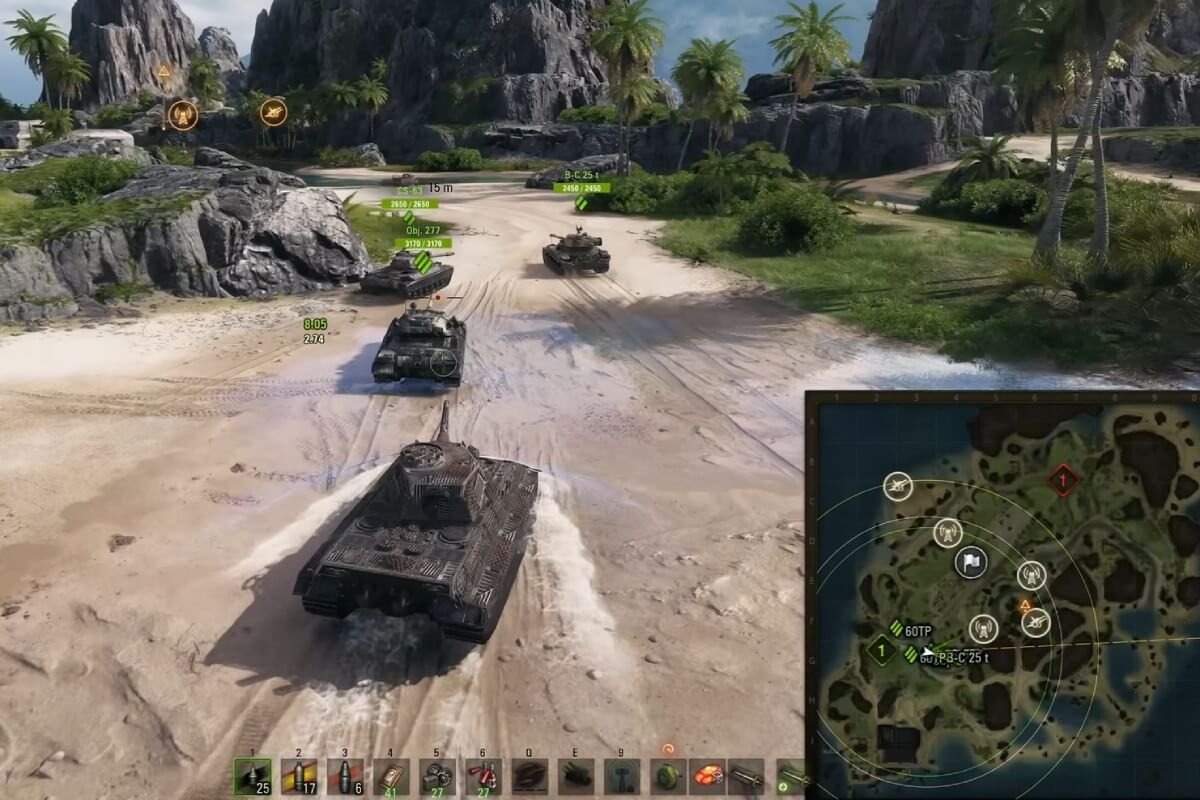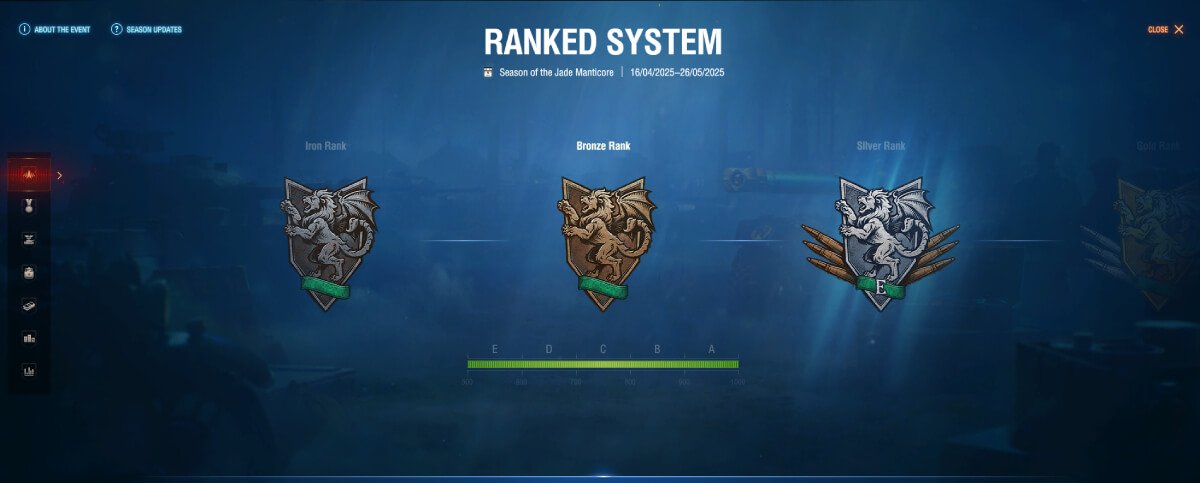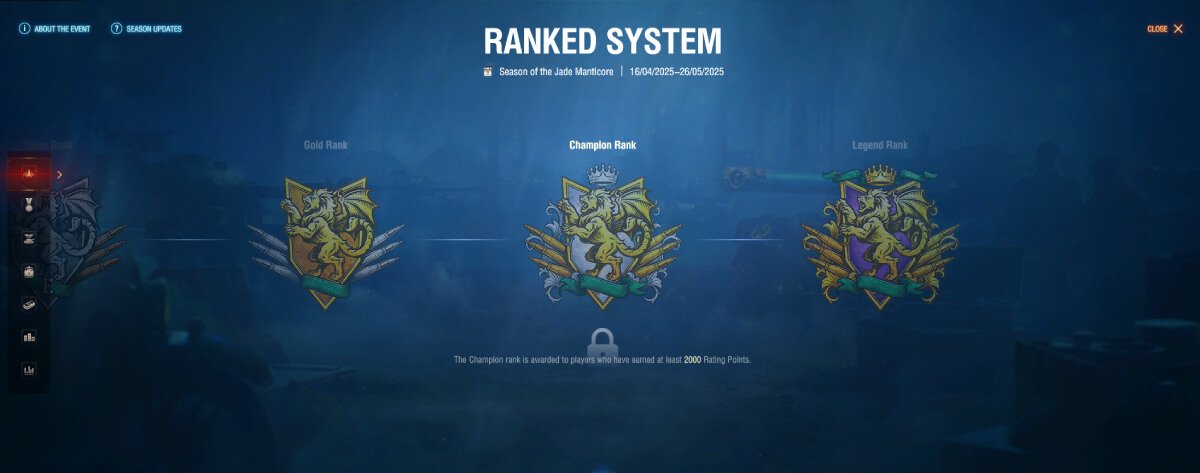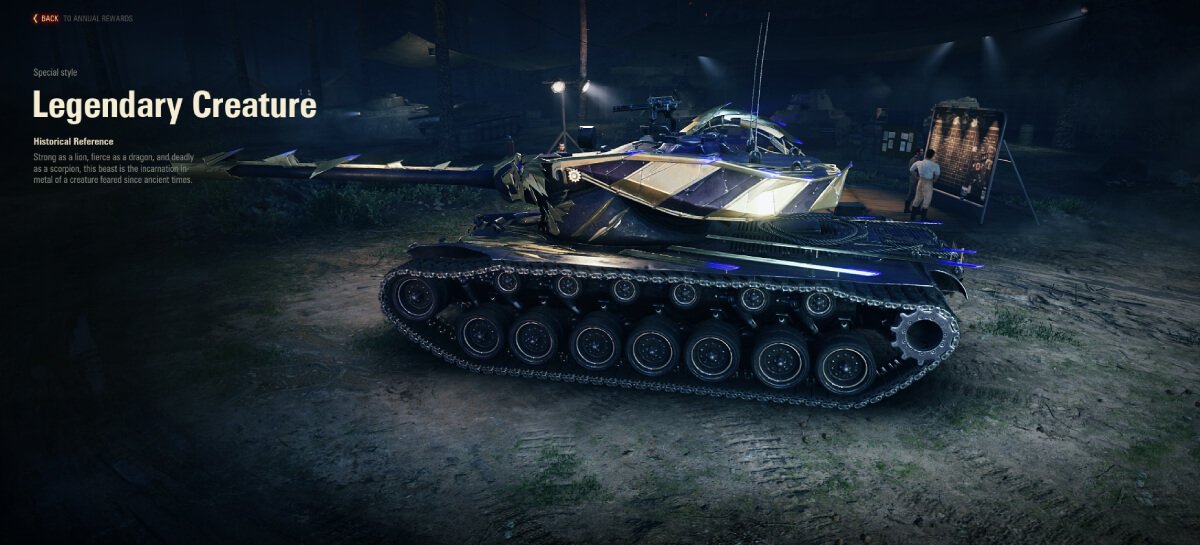Imagine dropping into battle with your finest Tier X vehicle, flanked by elite tankers, and knowing every shot, every skill, every decision could push you up the ranks—or send you crashing down. That’s the high-stakes thrill of Onslaught in World of Tanks. This game mode doesn’t hand out victories. It demands smart positioning, quick decision-making, and full understanding of mechanics like Role Skills, Fog of War, and Points of Interest. Whether you’re in it for the leaderboards or the seasonal rewards, this is where skill meets structure. The tight 7v7 format ensures that every move matters, especially when you’re facing opponents of equal caliber. For competitive tankers, it’s a rewarding test of mettle, discipline, and meta-awareness.

TL;DR: What Makes Onslaught Worth Your Time
- Tier X-only 7v7 competitive mode featuring ranked matchmaking, six rank tiers, and Prestige Points
- Unlock powerful Role Skills and Tactical Skills by performing in-battle actions and capturing POIs
- Fog of War system keeps enemy tank types hidden until spotted, enhancing tactical play
- Seasonal progression offers 2D styles, bonds, dog tags, and exclusive rental tanks
- Flexible entry for solo players, 2-player Platoons, or full Super Platoons of 7 players
What is Onslaught Mode in World of Tanks?
Onslaught is World of Tanks’ structured, ranked 7v7 mode for Tier X vehicles, tailored for players who want competitive progression and tactical depth. The mode is open exclusively to Tier X researchable vehicles (excluding SPGs), collector tanks, and selected specials. It’s not just a slugfest—it’s a tight, objective-driven format that pushes players to optimize every move. The battlefields have been adjusted for the 7v7 layout, making every square meter of the map a key battleground. This isn’t a casual mode to blow off steam—it’s a serious test of your vehicle knowledge, team coordination, and mechanical skill. Onslaught is structured into seasonal cycles, with each bringing updated maps, rule tweaks, and reward systems. Whether you’re gunning for the top 15% or climbing from Iron to Champion, every match affects your standing. Victory isn’t just about frags; it’s about controlling the tempo, capturing objectives, and playing as a unit. It’s also one of the few modes where tactical mastery often outweighs raw stats. Onslaught encourages deep strategic play, offering elite players an evolving environment in which skill, communication, and adaptability define success.
Pre-Battle Prep: Choose Wisely, Play Boldly
Pre-Battle Preparation adds a unique strategic layer to Onslaught. Once the map loads, you’ll see the positioning of your teammates and get a brief window to adjust your vehicle and configuration. This is only available if you’ve unlocked the Alternate Configuration Field Modification. Your vehicle’s starting spot is marked in orange, giving you insight into your opening role. Smart teams use this info to adjust their composition—for example, substituting a flanking medium for a hull-down heavy. Keep in mind that only fully crewed, repaired, and armed tanks can be selected, so prep your garage accordingly. Once you confirm your selection or the countdown ends, you’re locked in. At this moment, synergy matters: a random lineup of high-tier tanks won’t cut it. Pre-battle decisions can set the tone for the whole match. Teams that coordinate their vehicles and understand each tank’s role can gain a positional or tactical advantage before the first shot is fired. That preparation window also tests your awareness: it’s not just about your pick—it’s about complementing your team while anticipating what the enemy might bring to the fight.
Insider Tip:
Players who scout their allies’ picks and anticipate team roles often find better success. For example, if your teammates are rolling double heavies, consider supporting with a TD or light tank for balance. Watch the map, read the meta, and adapt before the countdown hits zero. You don’t always have to bring your strongest tank—sometimes, bringing the right tool for the terrain and synergy matters more. On maps with long sightlines, prioritizing vision can outweigh armor. If you’re the last one picking, avoid redundancy and bring balance to the lineup. Take this short phase seriously—it’s your first move in a game of tactical chess.
Fog of War: Strategic Ambiguity

Fog of War is one of Onslaught’s most intriguing twists. It conceals enemy vehicles until they’re spotted, creating a battlefield where information is as valuable as firepower. At the start of the match, you’ll know the names and ranks of enemy players—but not what tanks they’ve brought. This puts a premium on vision control, coordinated scouting, and early aggression. Light tanks with Recon Flight or mediums with Active Recon become your best bet for initiating contact safely. The mechanic also keeps players guessing—was that last tank a TD or a flanker? Should you commit, or reposition? Fog of War forces players to rely on instincts, prediction, and coordination. It transforms early-game maneuvering into a tense chess match, rewarding the teams that secure map control and vision dominance. This also makes stealth builds and bush tactics more viable than usual. The best teams use this system not just to delay detection, but to bait enemies into poor decisions. Knowing how and when to reveal your presence becomes a skill of its own. This mode favors teams who can control intel as effectively as they control angles.
Points of Interest (POIs) and Tactical Skills
POIs are one of the high-impact mechanics that can swing Onslaught matches. These designated zones, when captured, unlock a single-use Tactical Skill that delivers strategic firepower or teamwide vision advantage. There are two types:
- Artillery Headquarters: Unleashes an artillery strike. Enemy tanks are damaged and stunned; allies caught in the blast are only stunned.
- Comms Center: Activates a radar pulse that spots all enemy tanks for a limited time.
POIs can only be captured by one vehicle at a time. If you’re hit during the capture, the timer resets, and you’ll need to wait before trying again. Once the Tactical Skill is used, the POI will be disabled temporarily before becoming available again. Capturing POIs isn’t just about brute force—it’s about timing and cover. On open maps like Steppes, you’ll need screeners to draw fire while a teammate captures. Use POIs effectively, and you can set up an ambush, win a flank, or deny the enemy a comeback. The ability to flip momentum with one well-timed Tactical Skill is one of the things that makes Onslaught unique. Prioritize POI control in your team strategy—because missing out on one can mean missing out on the win.
Role Skills: Your Tank, Your Power
Each vehicle in Onslaught carries more than just firepower—it comes equipped with a Role Skill unique to its tank class. These skills are charged by earning Prestige Points through in-battle actions, and they can drastically influence outcomes if used wisely. Light tanks, for example, benefit from Recon Flight, which reveals enemy positions in a targeted area, making them the eyes of the team. Medium tanks get Active Recon, which extends their view range and rewards them for spotting kills. Heavy tanks can use Field Repairs to gradually restore the hit points of nearby allies, offering critical mid-fight support. Tank destroyers leverage Bullseye, enhancing accuracy and damage output for the next shot—perfect for turning ambushes into eliminations.
Each Role Skill has up to three charge levels, and activating it burns all accumulated charge. The power of the effect scales with the charge level, so timing matters. Burn early to gain quick momentum, or hold off and unleash a high-impact skill during a turning point. This dynamic introduces deep decision-making: play aggressive for fast charges, or steady for max impact? Teams that synchronize Role Skill use can overwhelm opponents, especially when combining vision tools with healing or damage. These skills aren’t gimmicks—they’re game-changers when coordinated.
Prestige Points: The Currency of Combat
Prestige Points are the backbone of your personal progression in Onslaught. They charge your Role Skill and influence your team contribution score, making every action on the battlefield count. Earn Prestige Points through a wide range of actions like spotting enemies, dealing damage, blocking shots, destroying tracks, capturing bases, and using Tactical Skills. Whether you’re a frontline brawler or a backline support, almost every meaningful action you take rewards you with Prestige Points. The system is designed to recognize not just damage dealers but also tactical and support players, encouraging diverse team roles.
Higher Prestige Point totals during a match mean faster Role Skill charges and higher visibility on the post-match scoreboard. In many cases, the top point-earners aren’t the ones with the most kills, but the ones who played smart, supported allies, or secured objectives. Prestige Points are what keep the economy of the match flowing and reward players who understand and adapt to the mode’s many layers. Want to dominate Onslaught? Don’t just think about kills—think about point generation, Role Skill synergy, and timely tactical execution. The more versatile your actions, the more power you unlock.
Combat Modifiers: The Meta Shifts
Combat Modifiers are a defining feature of Onslaught that differentiate it from standard World of Tanks gameplay. These mode-specific adjustments alter core tank mechanics to create a faster, more dynamic battlefield tailored for 7v7 engagements. Among the most noticeable changes are increased vehicle hit points, making tanks slightly tankier and fights more drawn out and tactical. Consumable cooldowns are reduced, encouraging players to use equipment like Repair Kits or Med Kits more frequently and tactically, instead of holding them back for emergencies.
Other modifiers include adjusted dispersion at 100m, which affects shot accuracy and tightens or loosens gun handling. The proximity spotting radius is increased, which makes sneaky ambushes harder unless you’re mastering terrain usage and view mechanics. Time visible after being spotted is also changed, allowing teams more time to react to threats. Additional modifiers tweak damage randomization, internal module damage, and engine fire chance, each designed to slightly shift the tactical meta. These changes aren’t just gimmicks—they’re engineered to support the faster pace and skill-based focus of Onslaught. Make sure to study the garage pop-up window that lists active modifiers each season so you can adapt your strategies accordingly.
Rank System: Earn Your Glory
Onslaught isn’t just about the thrill of battle—it’s about progression and prestige. The Rank System defines your competitive journey, consisting of six tiers: Iron, Bronze, Silver, Gold, Champion, and Legend. As you win battles and perform well, you gain Rating Points; lose too often or remain inactive, and you’ll start shedding points. Here’s the breakdown: Iron (0–500 points), Bronze (500–1000), Silver (1000–1500), Gold (1500–2000), Champion (2000+), and the top-tier Legend reserved for the top 15% of players on the leaderboard.

The first five ranks are divided into divisions (E to A), advancing every 100 Rating Points. Champion and Legend have no divisions and require consistent performance to maintain. The Leaderboard updates every five minutes, so competitive players can see real-time shifts in ranking.

Note that inactivity penalties apply to Silver rank and higher. You must regularly participate to avoid losing points due to depleted activity charges. The top dogs in the Legend rank are not only skilled but committed—maintaining your place requires constant high-level performance. Reaching the upper tiers offers prestige, rewards, and bragging rights, making every match more meaningful.
Tracking Progress in Onslaught: What the Rating Screen Really Tells You
Every match in Onslaught contributes to your climb—or fall—through the competitive ranks, and the game does a solid job of showing you exactly where you stand. After a battle, you’re greeted by a detailed progress screen that not only shows your current point total, but also illustrates your division’s location on the ladder. It’s not just a number—it’s a visual journey. Stylized badges represent each rank, while a sliding bar shows how close (or far) you are from the next milestone. Whether you’re moving up or hanging on, the feedback is immediate and motivating.
Another key element is the inactivity countdown. If you haven’t played in a while, the system reminds you how many days remain before you start losing progress. It’s a gentle push to stay active and keep your momentum going. Every match affects your standing, and that constant feedback loop makes the grind feel personal and engaging. It’s not just about prestige—it’s about accountability. And when you do rank up? The screen makes sure you know it. Few things are as satisfying as watching your badge glow just a little brighter.
Platoons and Super Platoons
Onslaught gives you the option to play solo, in a standard two-player Platoon, or to rally your entire crew as a full-blown Super Platoon of seven players. This opens up a wide range of team-based tactics and coordination that you simply can’t get in solo queuing. After completing the initial Qualification stage, the mode allows these group formats to jump into battle. But here’s the twist: Super Platoons only fight other Super Platoons. That means if you’re dropping in with a full squad, you’re guaranteed to face a similarly stacked and organized team on the enemy side.
This restriction maintains competitive integrity and ensures a level playing field. Super Platoons can bring devastating coordination to the battlefield, using voice chat, synchronized flanking, and ability timing to dominate engagements. If you’re serious about climbing the ranks, forming a regular crew and learning to communicate effectively will give you a noticeable edge. That said, solo players and duos still have strong matchmaking paths—teams are mixed depending on overall player count and division. Whether you’re queuing alone or with friends, the system keeps the balance fair, challenging, and rewarding.
Seasonal Goodies: Why It’s Worth Grinding
Onslaught isn’t just a test of tactical skill—it’s also a treasure trove of seasonal rewards. Each year is divided into three competitive seasons, and every season comes packed with exclusive rewards tied to your performance. These include progressive 2D styles that visually evolve as you rank up, badges, dog tags, stripes, and bonds for use in the in-game shop. The higher your rank by season’s end, the greater your loot haul. Players who reach Champion or Legend rank also receive daily bonds during ceasefire—25 and 50, respectively. It’s a consistent stream of value for dedicated players.
Each season also features weekly missions that reward tokens. These tokens can be exchanged for improved equipment—or converted into default rewards if unused. Rental Tier X vehicles like the Bat.-Châtillon 25 t are also handed out, giving every player a shot at elite combat, even if they don’t own Tier X tanks. Finally, by collecting Onslaught Colors throughout the year, you can unlock a major Annual Reward, which may include exclusive 3D styles, tokens, and a special reward tank. So if you’re in this for the long haul, Onslaught delivers more than just bragging rights—it delivers tangible, elite rewards that can reshape your garage.

Community Reactions and Challenges
As with any high-stakes competitive mode, Onslaught has stirred both excitement and debate within the World of Tanks community. Many veteran players praise it for introducing layered tactical depth, structured ranking, and a rewarding progression system that finally puts skill-based gameplay front and center. The inclusion of Fog of War, Role Skills, and Tactical POIs has been described as refreshing, offering more dynamic matches compared to standard Random Battles. For players who enjoy competitive formats like Ranked or Clan Wars, Onslaught serves as a thrilling, solo-friendly alternative that still demands communication and strategy.
However, not all feedback is glowing. Some players criticize the time commitment required to climb the rankings, especially with the risk of losing Rating Points due to inactivity. Others find the balance of Role Skills and Combat Modifiers tricky, noting that certain tank roles feel overpowered in the current meta. The Super Platoon restriction has also been a topic of contention—while it ensures fairness, it can limit casual group play. Despite this, the majority of feedback leans positive, with players appreciating Wargaming’s effort to create a truly competitive environment. Onslaught remains a mode that rewards not just reflexes, but deep knowledge of the game’s evolving mechanics.
Conclusion: Why Onslaught is a Must-Play for Competitive Tankers
Onslaught in World of Tanks is more than just another mode—it’s a competitive ecosystem crafted for the serious tanker. With its ranked progression, powerful role-based skills, and mode-defining mechanics like Fog of War and Tactical POIs, Onslaught brings strategy and structure to the forefront of gameplay. Players seeking more than just casual fun will find in Onslaught a test of timing, coordination, and battlefield IQ. It’s not without its challenges—time commitment, meta shifts, and occasional balance concerns—but the depth and rewards are well worth the grind. Whether you’re playing solo, with a duo, or rolling in with a Super Platoon, the mode offers intense battles that are both fair and fiercely competitive. With seasonal rewards, leaderboard rankings, and evolving meta updates, Onslaught is a mode built to last and thrive. For players who want to sharpen their skills, climb the ranks, and leave their mark—this is the battlefield that counts.


